The Impact of Gig Economy on Business Organisation
VerifiedAdded on 2020/09/17
|9
|2208
|37
AI Summary
The assignment delves into the world of gig economy and its influence on business organisation. It examines the pros and cons of adopting gig economy, highlighting its potential to enhance production efficiency while also posing challenges such as maintaining a positive work environment and ensuring employee engagement. The document provides references to relevant studies and articles to support its findings.
Contribute Materials
Your contribution can guide someone’s learning journey. Share your
documents today.
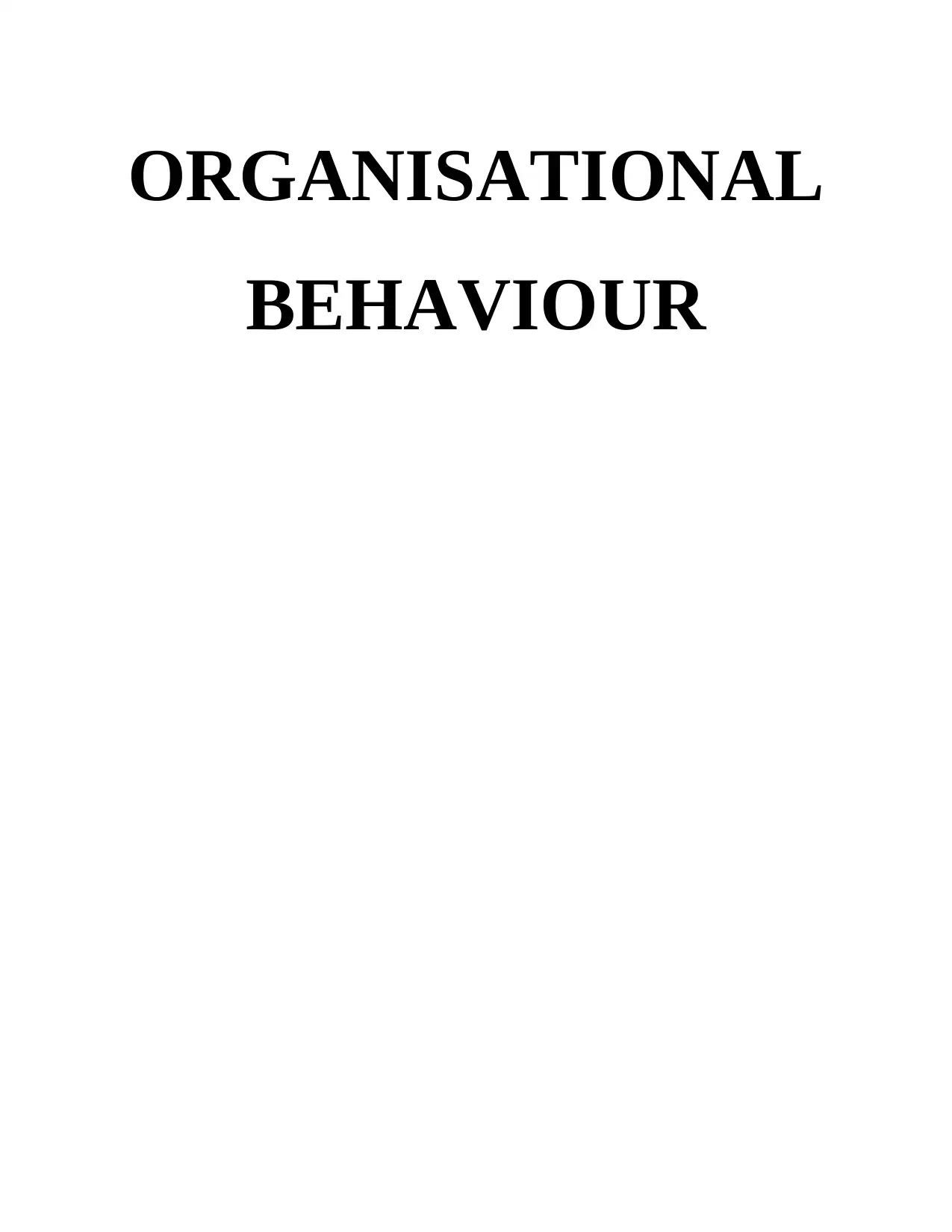
ORGANISATIONAL
BEHAVIOUR
BEHAVIOUR
Secure Best Marks with AI Grader
Need help grading? Try our AI Grader for instant feedback on your assignments.

TABLE OF CONTENTS
INTRODUCTION...........................................................................................................................1
PART 1 ...........................................................................................................................................1
PART 2 ...........................................................................................................................................5
CONCLUSION ...............................................................................................................................5
REFERENCES ...............................................................................................................................6
INTRODUCTION...........................................................................................................................1
PART 1 ...........................................................................................................................................1
PART 2 ...........................................................................................................................................5
CONCLUSION ...............................................................................................................................5
REFERENCES ...............................................................................................................................6
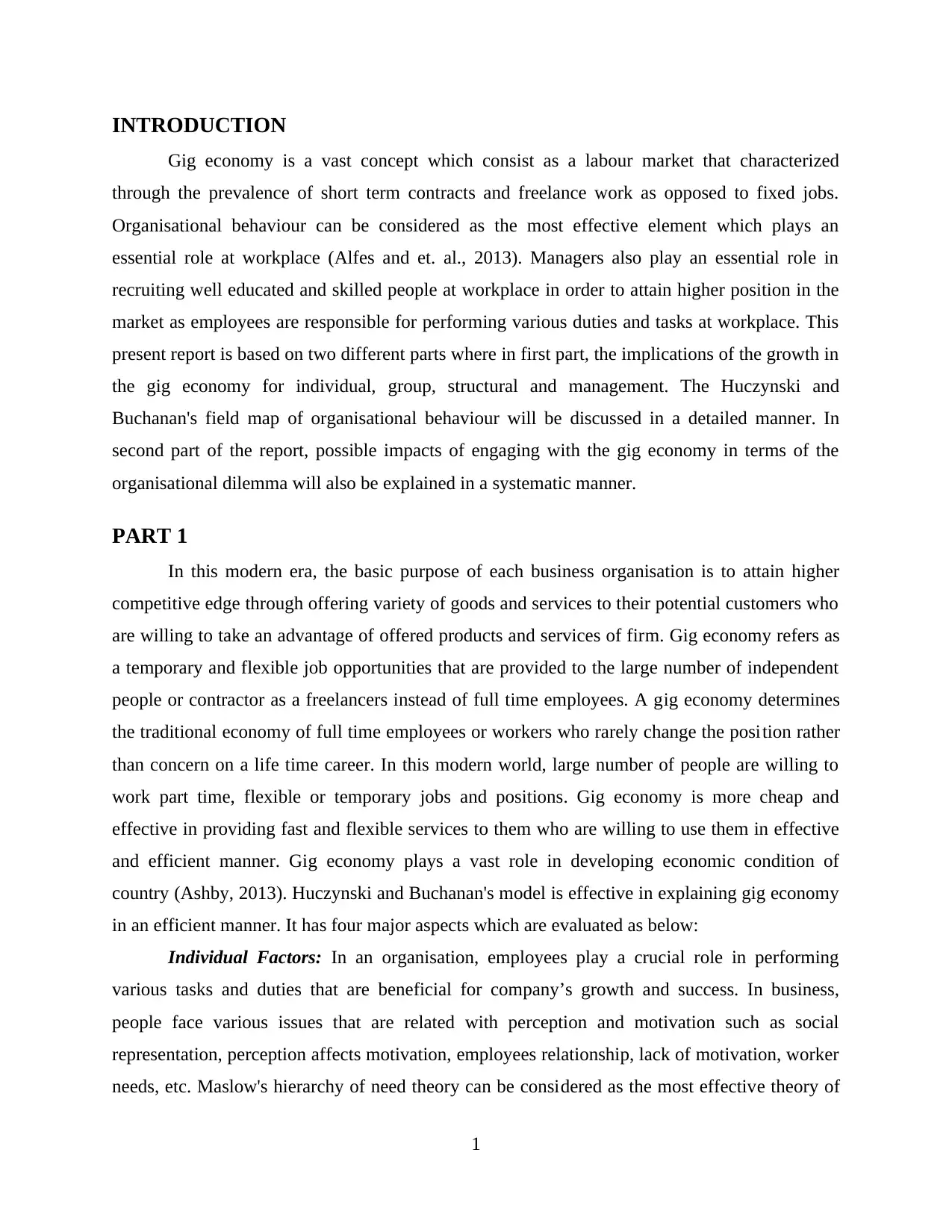
INTRODUCTION
Gig economy is a vast concept which consist as a labour market that characterized
through the prevalence of short term contracts and freelance work as opposed to fixed jobs.
Organisational behaviour can be considered as the most effective element which plays an
essential role at workplace (Alfes and et. al., 2013). Managers also play an essential role in
recruiting well educated and skilled people at workplace in order to attain higher position in the
market as employees are responsible for performing various duties and tasks at workplace. This
present report is based on two different parts where in first part, the implications of the growth in
the gig economy for individual, group, structural and management. The Huczynski and
Buchanan's field map of organisational behaviour will be discussed in a detailed manner. In
second part of the report, possible impacts of engaging with the gig economy in terms of the
organisational dilemma will also be explained in a systematic manner.
PART 1
In this modern era, the basic purpose of each business organisation is to attain higher
competitive edge through offering variety of goods and services to their potential customers who
are willing to take an advantage of offered products and services of firm. Gig economy refers as
a temporary and flexible job opportunities that are provided to the large number of independent
people or contractor as a freelancers instead of full time employees. A gig economy determines
the traditional economy of full time employees or workers who rarely change the position rather
than concern on a life time career. In this modern world, large number of people are willing to
work part time, flexible or temporary jobs and positions. Gig economy is more cheap and
effective in providing fast and flexible services to them who are willing to use them in effective
and efficient manner. Gig economy plays a vast role in developing economic condition of
country (Ashby, 2013). Huczynski and Buchanan's model is effective in explaining gig economy
in an efficient manner. It has four major aspects which are evaluated as below:
Individual Factors: In an organisation, employees play a crucial role in performing
various tasks and duties that are beneficial for company’s growth and success. In business,
people face various issues that are related with perception and motivation such as social
representation, perception affects motivation, employees relationship, lack of motivation, worker
needs, etc. Maslow's hierarchy of need theory can be considered as the most effective theory of
1
Gig economy is a vast concept which consist as a labour market that characterized
through the prevalence of short term contracts and freelance work as opposed to fixed jobs.
Organisational behaviour can be considered as the most effective element which plays an
essential role at workplace (Alfes and et. al., 2013). Managers also play an essential role in
recruiting well educated and skilled people at workplace in order to attain higher position in the
market as employees are responsible for performing various duties and tasks at workplace. This
present report is based on two different parts where in first part, the implications of the growth in
the gig economy for individual, group, structural and management. The Huczynski and
Buchanan's field map of organisational behaviour will be discussed in a detailed manner. In
second part of the report, possible impacts of engaging with the gig economy in terms of the
organisational dilemma will also be explained in a systematic manner.
PART 1
In this modern era, the basic purpose of each business organisation is to attain higher
competitive edge through offering variety of goods and services to their potential customers who
are willing to take an advantage of offered products and services of firm. Gig economy refers as
a temporary and flexible job opportunities that are provided to the large number of independent
people or contractor as a freelancers instead of full time employees. A gig economy determines
the traditional economy of full time employees or workers who rarely change the position rather
than concern on a life time career. In this modern world, large number of people are willing to
work part time, flexible or temporary jobs and positions. Gig economy is more cheap and
effective in providing fast and flexible services to them who are willing to use them in effective
and efficient manner. Gig economy plays a vast role in developing economic condition of
country (Ashby, 2013). Huczynski and Buchanan's model is effective in explaining gig economy
in an efficient manner. It has four major aspects which are evaluated as below:
Individual Factors: In an organisation, employees play a crucial role in performing
various tasks and duties that are beneficial for company’s growth and success. In business,
people face various issues that are related with perception and motivation such as social
representation, perception affects motivation, employees relationship, lack of motivation, worker
needs, etc. Maslow's hierarchy of need theory can be considered as the most effective theory of
1
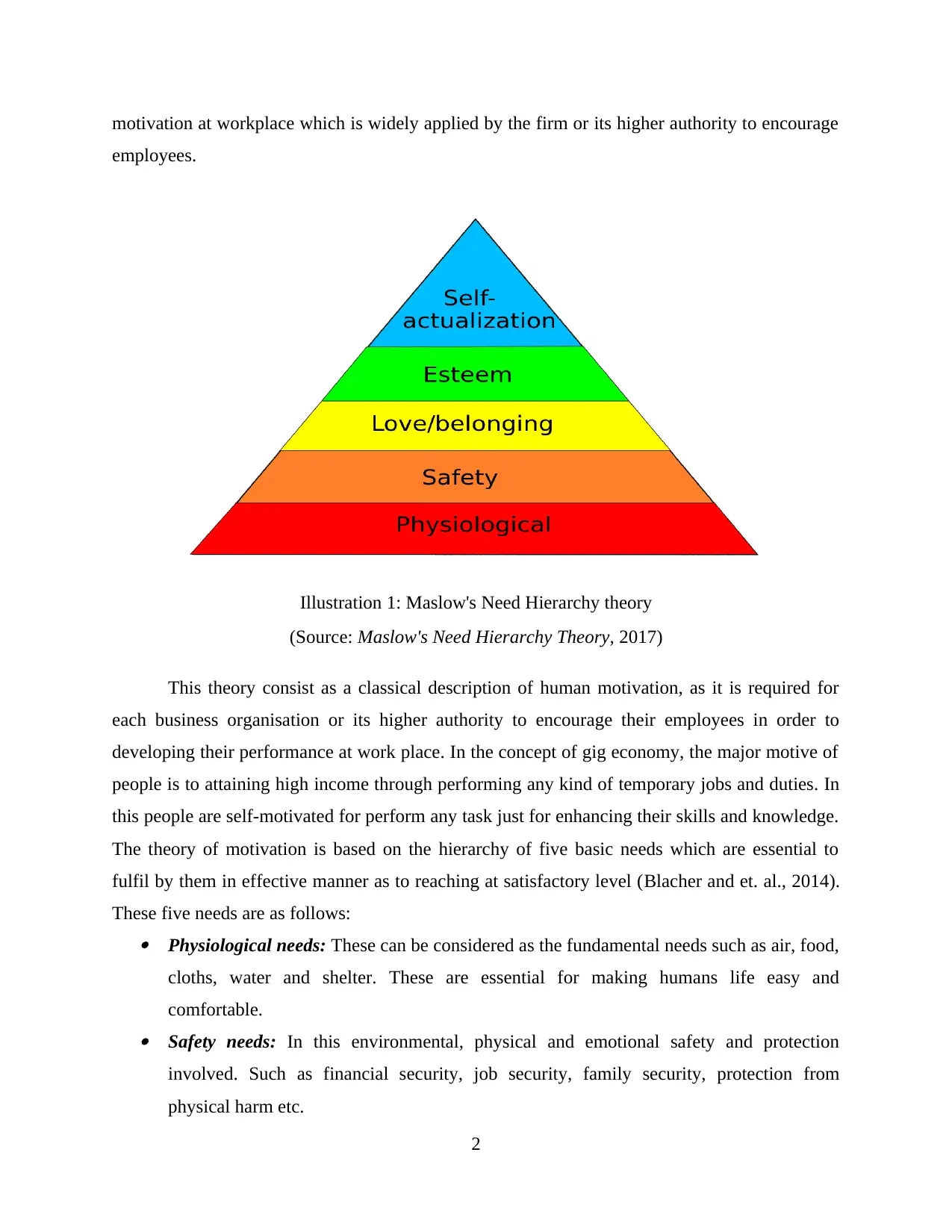
motivation at workplace which is widely applied by the firm or its higher authority to encourage
employees.
(Source: Maslow's Need Hierarchy Theory, 2017)
This theory consist as a classical description of human motivation, as it is required for
each business organisation or its higher authority to encourage their employees in order to
developing their performance at work place. In the concept of gig economy, the major motive of
people is to attaining high income through performing any kind of temporary jobs and duties. In
this people are self-motivated for perform any task just for enhancing their skills and knowledge.
The theory of motivation is based on the hierarchy of five basic needs which are essential to
fulfil by them in effective manner as to reaching at satisfactory level (Blacher and et. al., 2014).
These five needs are as follows: Physiological needs: These can be considered as the fundamental needs such as air, food,
cloths, water and shelter. These are essential for making humans life easy and
comfortable. Safety needs: In this environmental, physical and emotional safety and protection
involved. Such as financial security, job security, family security, protection from
physical harm etc.
2
Illustration 1: Maslow's Need Hierarchy theory
employees.
(Source: Maslow's Need Hierarchy Theory, 2017)
This theory consist as a classical description of human motivation, as it is required for
each business organisation or its higher authority to encourage their employees in order to
developing their performance at work place. In the concept of gig economy, the major motive of
people is to attaining high income through performing any kind of temporary jobs and duties. In
this people are self-motivated for perform any task just for enhancing their skills and knowledge.
The theory of motivation is based on the hierarchy of five basic needs which are essential to
fulfil by them in effective manner as to reaching at satisfactory level (Blacher and et. al., 2014).
These five needs are as follows: Physiological needs: These can be considered as the fundamental needs such as air, food,
cloths, water and shelter. These are essential for making humans life easy and
comfortable. Safety needs: In this environmental, physical and emotional safety and protection
involved. Such as financial security, job security, family security, protection from
physical harm etc.
2
Illustration 1: Maslow's Need Hierarchy theory
Secure Best Marks with AI Grader
Need help grading? Try our AI Grader for instant feedback on your assignments.
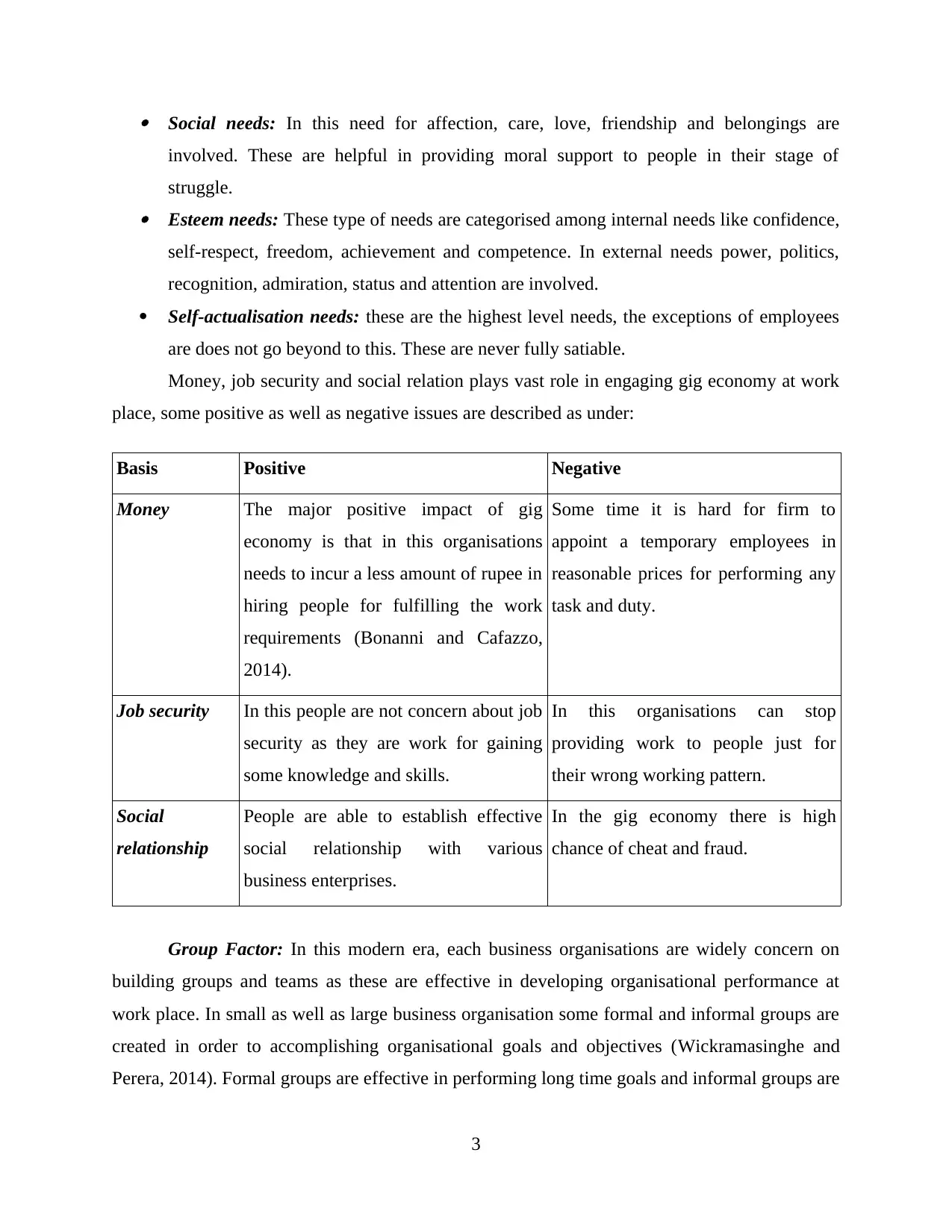
Social needs: In this need for affection, care, love, friendship and belongings are
involved. These are helpful in providing moral support to people in their stage of
struggle. Esteem needs: These type of needs are categorised among internal needs like confidence,
self-respect, freedom, achievement and competence. In external needs power, politics,
recognition, admiration, status and attention are involved.
Self-actualisation needs: these are the highest level needs, the exceptions of employees
are does not go beyond to this. These are never fully satiable.
Money, job security and social relation plays vast role in engaging gig economy at work
place, some positive as well as negative issues are described as under:
Basis Positive Negative
Money The major positive impact of gig
economy is that in this organisations
needs to incur a less amount of rupee in
hiring people for fulfilling the work
requirements (Bonanni and Cafazzo,
2014).
Some time it is hard for firm to
appoint a temporary employees in
reasonable prices for performing any
task and duty.
Job security In this people are not concern about job
security as they are work for gaining
some knowledge and skills.
In this organisations can stop
providing work to people just for
their wrong working pattern.
Social
relationship
People are able to establish effective
social relationship with various
business enterprises.
In the gig economy there is high
chance of cheat and fraud.
Group Factor: In this modern era, each business organisations are widely concern on
building groups and teams as these are effective in developing organisational performance at
work place. In small as well as large business organisation some formal and informal groups are
created in order to accomplishing organisational goals and objectives (Wickramasinghe and
Perera, 2014). Formal groups are effective in performing long time goals and informal groups are
3
involved. These are helpful in providing moral support to people in their stage of
struggle. Esteem needs: These type of needs are categorised among internal needs like confidence,
self-respect, freedom, achievement and competence. In external needs power, politics,
recognition, admiration, status and attention are involved.
Self-actualisation needs: these are the highest level needs, the exceptions of employees
are does not go beyond to this. These are never fully satiable.
Money, job security and social relation plays vast role in engaging gig economy at work
place, some positive as well as negative issues are described as under:
Basis Positive Negative
Money The major positive impact of gig
economy is that in this organisations
needs to incur a less amount of rupee in
hiring people for fulfilling the work
requirements (Bonanni and Cafazzo,
2014).
Some time it is hard for firm to
appoint a temporary employees in
reasonable prices for performing any
task and duty.
Job security In this people are not concern about job
security as they are work for gaining
some knowledge and skills.
In this organisations can stop
providing work to people just for
their wrong working pattern.
Social
relationship
People are able to establish effective
social relationship with various
business enterprises.
In the gig economy there is high
chance of cheat and fraud.
Group Factor: In this modern era, each business organisations are widely concern on
building groups and teams as these are effective in developing organisational performance at
work place. In small as well as large business organisation some formal and informal groups are
created in order to accomplishing organisational goals and objectives (Wickramasinghe and
Perera, 2014). Formal groups are effective in performing long time goals and informal groups are
3
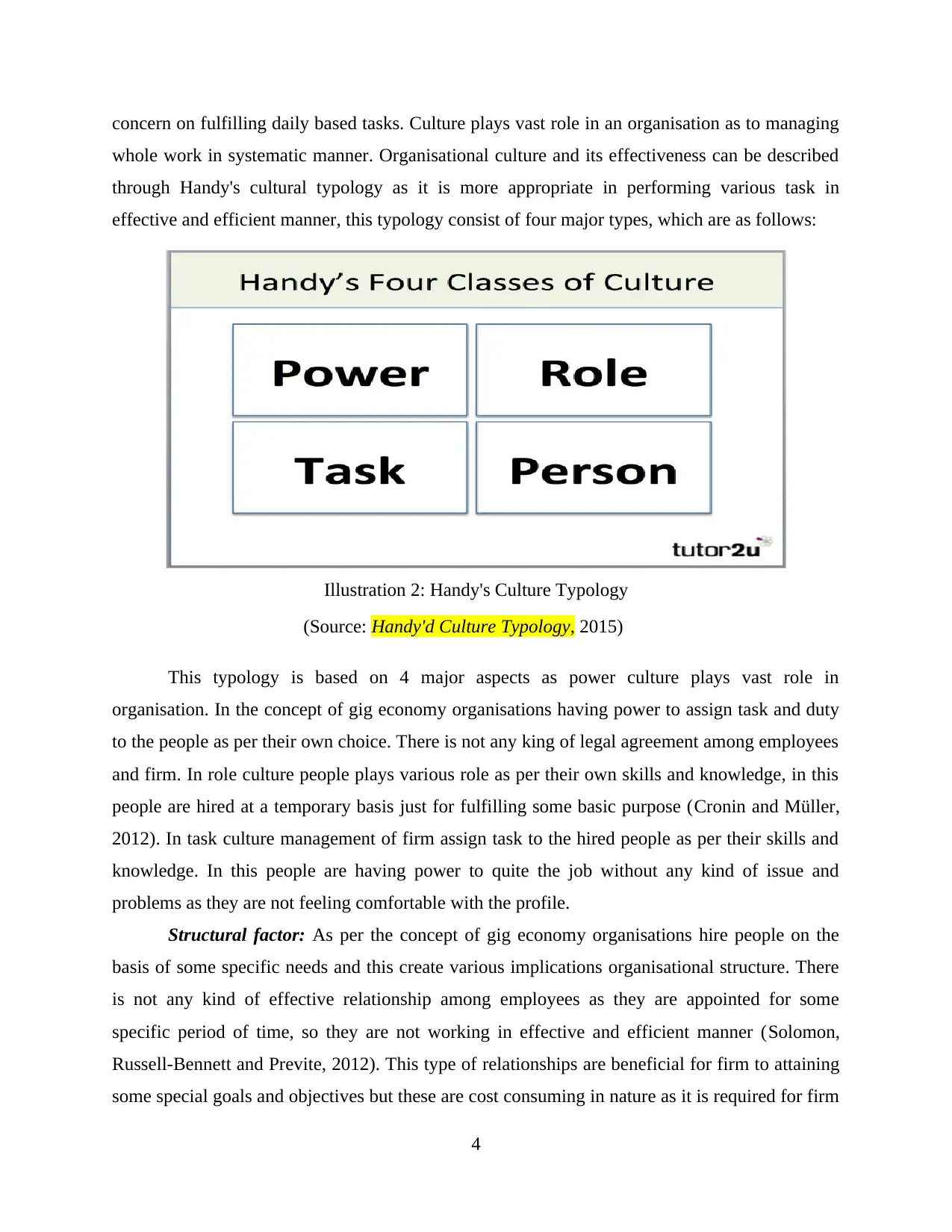
concern on fulfilling daily based tasks. Culture plays vast role in an organisation as to managing
whole work in systematic manner. Organisational culture and its effectiveness can be described
through Handy's cultural typology as it is more appropriate in performing various task in
effective and efficient manner, this typology consist of four major types, which are as follows:
(Source: Handy'd Culture Typology, 2015)
This typology is based on 4 major aspects as power culture plays vast role in
organisation. In the concept of gig economy organisations having power to assign task and duty
to the people as per their own choice. There is not any king of legal agreement among employees
and firm. In role culture people plays various role as per their own skills and knowledge, in this
people are hired at a temporary basis just for fulfilling some basic purpose (Cronin and Müller,
2012). In task culture management of firm assign task to the hired people as per their skills and
knowledge. In this people are having power to quite the job without any kind of issue and
problems as they are not feeling comfortable with the profile.
Structural factor: As per the concept of gig economy organisations hire people on the
basis of some specific needs and this create various implications organisational structure. There
is not any kind of effective relationship among employees as they are appointed for some
specific period of time, so they are not working in effective and efficient manner (Solomon,
Russell-Bennett and Previte, 2012). This type of relationships are beneficial for firm to attaining
some special goals and objectives but these are cost consuming in nature as it is required for firm
4
Illustration 2: Handy's Culture Typology
whole work in systematic manner. Organisational culture and its effectiveness can be described
through Handy's cultural typology as it is more appropriate in performing various task in
effective and efficient manner, this typology consist of four major types, which are as follows:
(Source: Handy'd Culture Typology, 2015)
This typology is based on 4 major aspects as power culture plays vast role in
organisation. In the concept of gig economy organisations having power to assign task and duty
to the people as per their own choice. There is not any king of legal agreement among employees
and firm. In role culture people plays various role as per their own skills and knowledge, in this
people are hired at a temporary basis just for fulfilling some basic purpose (Cronin and Müller,
2012). In task culture management of firm assign task to the hired people as per their skills and
knowledge. In this people are having power to quite the job without any kind of issue and
problems as they are not feeling comfortable with the profile.
Structural factor: As per the concept of gig economy organisations hire people on the
basis of some specific needs and this create various implications organisational structure. There
is not any kind of effective relationship among employees as they are appointed for some
specific period of time, so they are not working in effective and efficient manner (Solomon,
Russell-Bennett and Previte, 2012). This type of relationships are beneficial for firm to attaining
some special goals and objectives but these are cost consuming in nature as it is required for firm
4
Illustration 2: Handy's Culture Typology
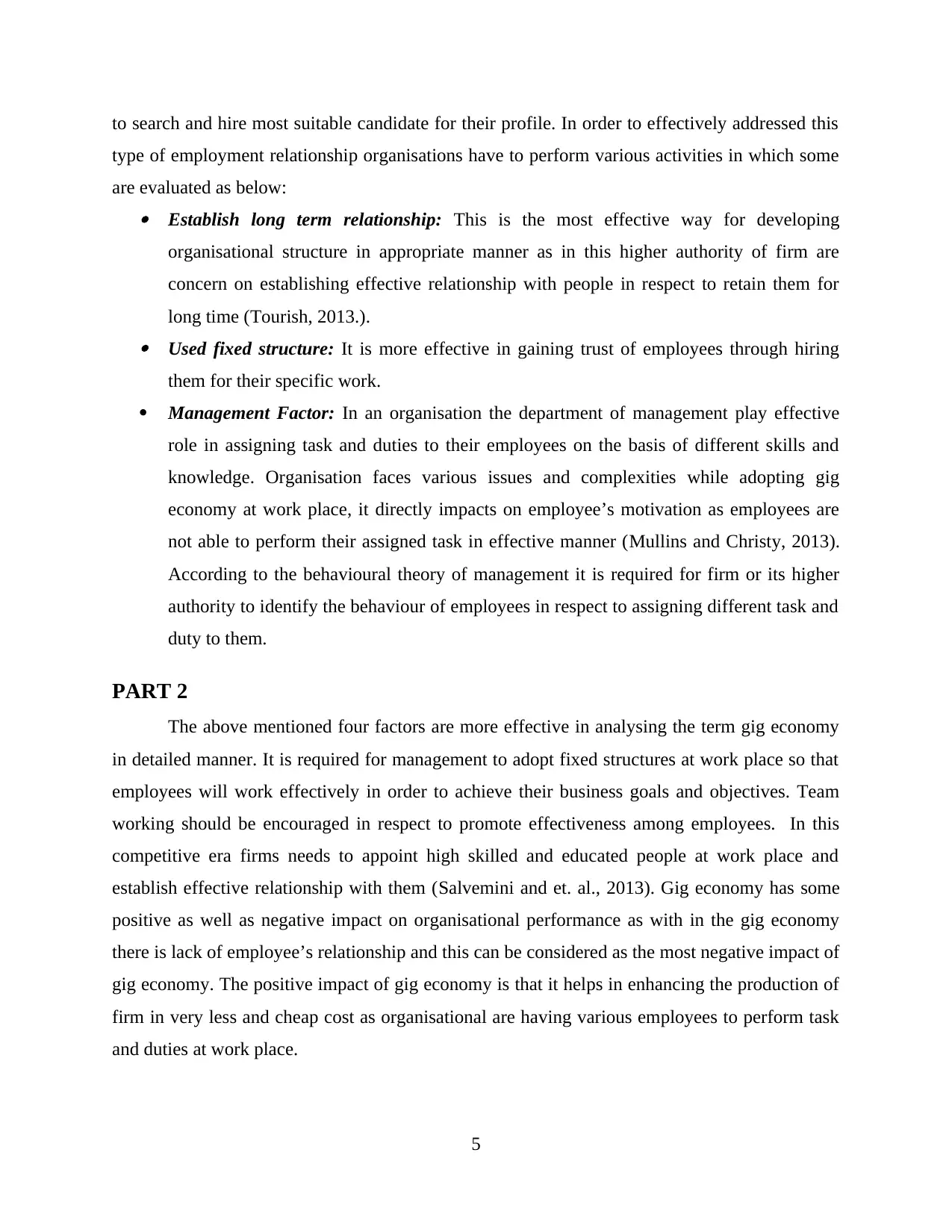
to search and hire most suitable candidate for their profile. In order to effectively addressed this
type of employment relationship organisations have to perform various activities in which some
are evaluated as below: Establish long term relationship: This is the most effective way for developing
organisational structure in appropriate manner as in this higher authority of firm are
concern on establishing effective relationship with people in respect to retain them for
long time (Tourish, 2013.). Used fixed structure: It is more effective in gaining trust of employees through hiring
them for their specific work.
Management Factor: In an organisation the department of management play effective
role in assigning task and duties to their employees on the basis of different skills and
knowledge. Organisation faces various issues and complexities while adopting gig
economy at work place, it directly impacts on employee’s motivation as employees are
not able to perform their assigned task in effective manner (Mullins and Christy, 2013).
According to the behavioural theory of management it is required for firm or its higher
authority to identify the behaviour of employees in respect to assigning different task and
duty to them.
PART 2
The above mentioned four factors are more effective in analysing the term gig economy
in detailed manner. It is required for management to adopt fixed structures at work place so that
employees will work effectively in order to achieve their business goals and objectives. Team
working should be encouraged in respect to promote effectiveness among employees. In this
competitive era firms needs to appoint high skilled and educated people at work place and
establish effective relationship with them (Salvemini and et. al., 2013). Gig economy has some
positive as well as negative impact on organisational performance as with in the gig economy
there is lack of employee’s relationship and this can be considered as the most negative impact of
gig economy. The positive impact of gig economy is that it helps in enhancing the production of
firm in very less and cheap cost as organisational are having various employees to perform task
and duties at work place.
5
type of employment relationship organisations have to perform various activities in which some
are evaluated as below: Establish long term relationship: This is the most effective way for developing
organisational structure in appropriate manner as in this higher authority of firm are
concern on establishing effective relationship with people in respect to retain them for
long time (Tourish, 2013.). Used fixed structure: It is more effective in gaining trust of employees through hiring
them for their specific work.
Management Factor: In an organisation the department of management play effective
role in assigning task and duties to their employees on the basis of different skills and
knowledge. Organisation faces various issues and complexities while adopting gig
economy at work place, it directly impacts on employee’s motivation as employees are
not able to perform their assigned task in effective manner (Mullins and Christy, 2013).
According to the behavioural theory of management it is required for firm or its higher
authority to identify the behaviour of employees in respect to assigning different task and
duty to them.
PART 2
The above mentioned four factors are more effective in analysing the term gig economy
in detailed manner. It is required for management to adopt fixed structures at work place so that
employees will work effectively in order to achieve their business goals and objectives. Team
working should be encouraged in respect to promote effectiveness among employees. In this
competitive era firms needs to appoint high skilled and educated people at work place and
establish effective relationship with them (Salvemini and et. al., 2013). Gig economy has some
positive as well as negative impact on organisational performance as with in the gig economy
there is lack of employee’s relationship and this can be considered as the most negative impact of
gig economy. The positive impact of gig economy is that it helps in enhancing the production of
firm in very less and cheap cost as organisational are having various employees to perform task
and duties at work place.
5
Paraphrase This Document
Need a fresh take? Get an instant paraphrase of this document with our AI Paraphraser
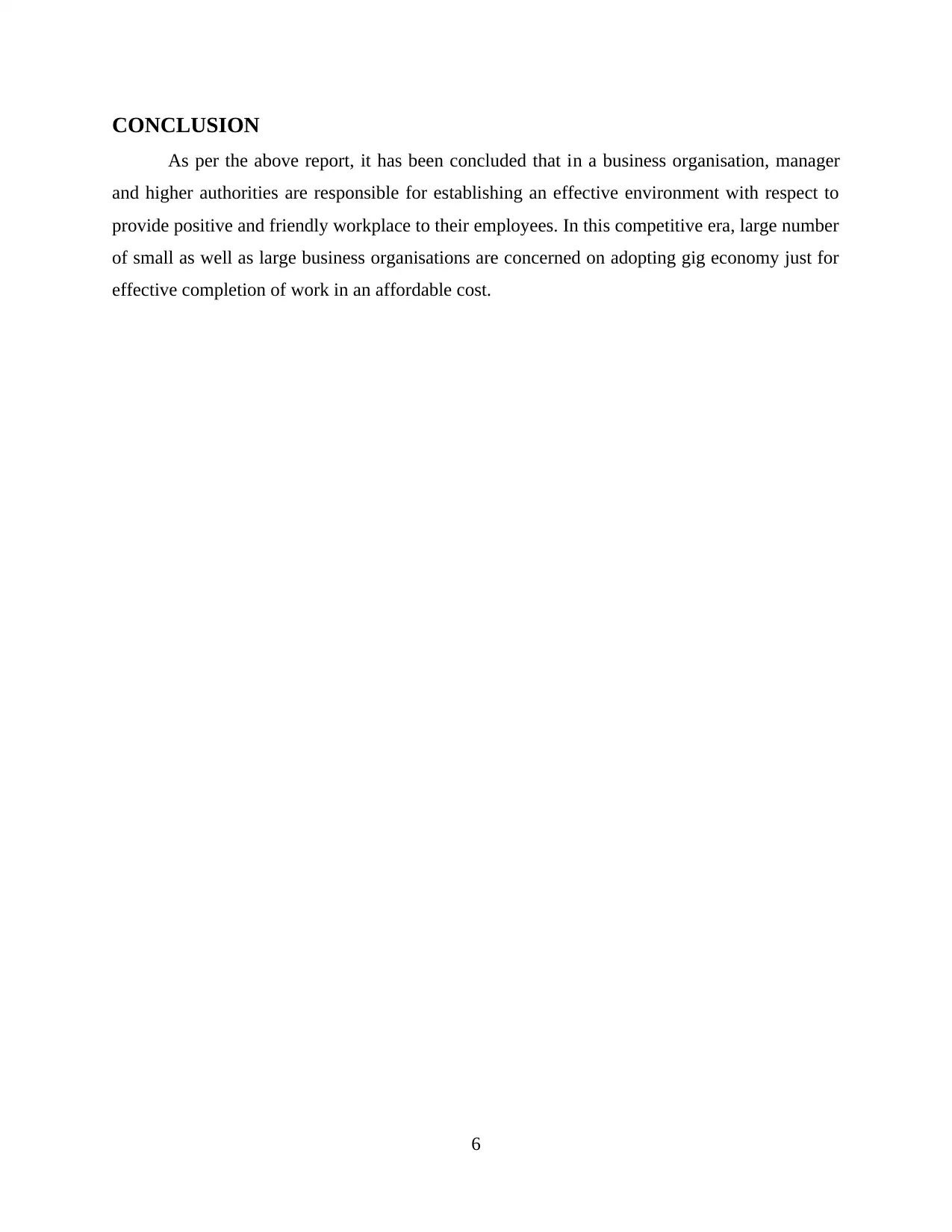
CONCLUSION
As per the above report, it has been concluded that in a business organisation, manager
and higher authorities are responsible for establishing an effective environment with respect to
provide positive and friendly workplace to their employees. In this competitive era, large number
of small as well as large business organisations are concerned on adopting gig economy just for
effective completion of work in an affordable cost.
6
As per the above report, it has been concluded that in a business organisation, manager
and higher authorities are responsible for establishing an effective environment with respect to
provide positive and friendly workplace to their employees. In this competitive era, large number
of small as well as large business organisations are concerned on adopting gig economy just for
effective completion of work in an affordable cost.
6
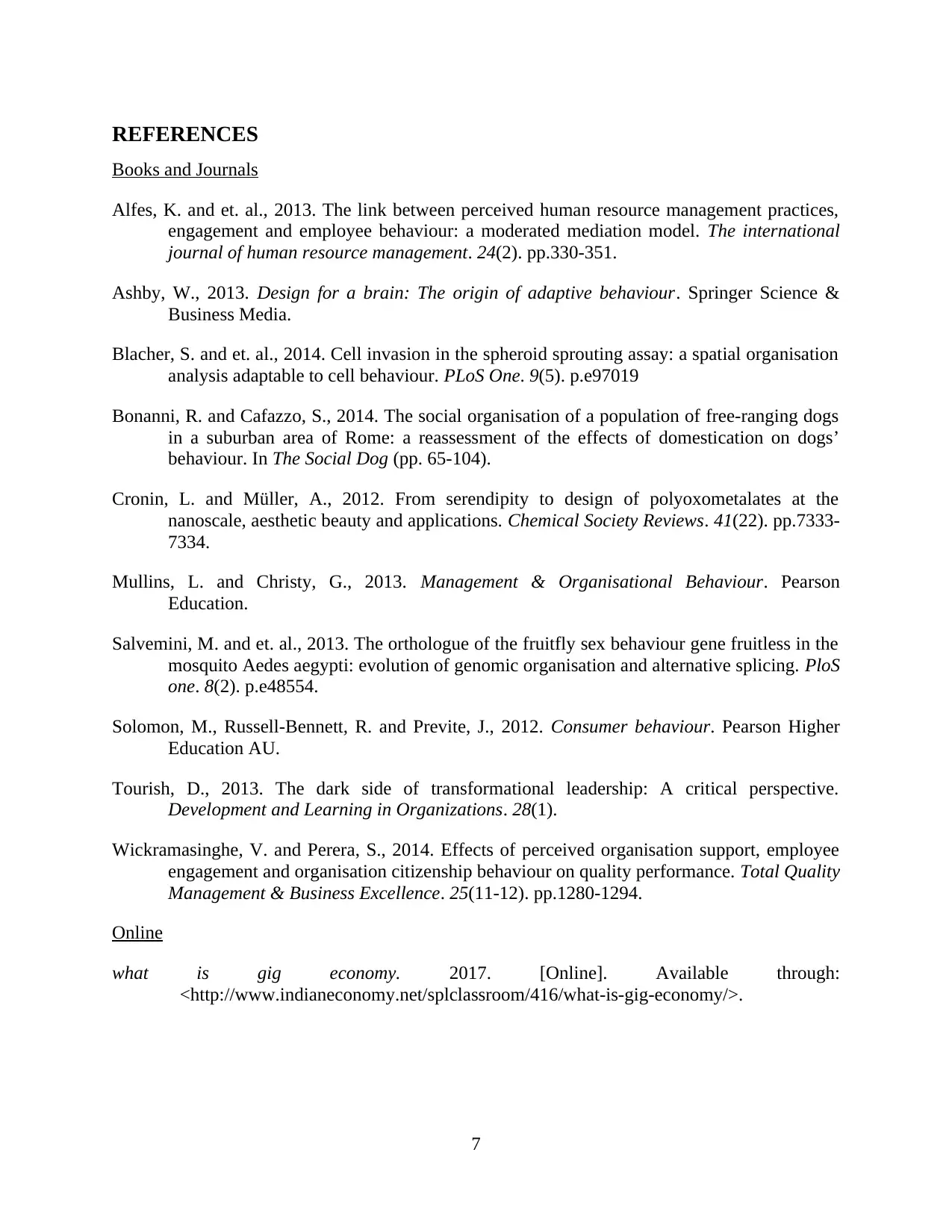
REFERENCES
Books and Journals
Alfes, K. and et. al., 2013. The link between perceived human resource management practices,
engagement and employee behaviour: a moderated mediation model. The international
journal of human resource management. 24(2). pp.330-351.
Ashby, W., 2013. Design for a brain: The origin of adaptive behaviour. Springer Science &
Business Media.
Blacher, S. and et. al., 2014. Cell invasion in the spheroid sprouting assay: a spatial organisation
analysis adaptable to cell behaviour. PLoS One. 9(5). p.e97019
Bonanni, R. and Cafazzo, S., 2014. The social organisation of a population of free-ranging dogs
in a suburban area of Rome: a reassessment of the effects of domestication on dogs’
behaviour. In The Social Dog (pp. 65-104).
Cronin, L. and Müller, A., 2012. From serendipity to design of polyoxometalates at the
nanoscale, aesthetic beauty and applications. Chemical Society Reviews. 41(22). pp.7333-
7334.
Mullins, L. and Christy, G., 2013. Management & Organisational Behaviour. Pearson
Education.
Salvemini, M. and et. al., 2013. The orthologue of the fruitfly sex behaviour gene fruitless in the
mosquito Aedes aegypti: evolution of genomic organisation and alternative splicing. PloS
one. 8(2). p.e48554.
Solomon, M., Russell-Bennett, R. and Previte, J., 2012. Consumer behaviour. Pearson Higher
Education AU.
Tourish, D., 2013. The dark side of transformational leadership: A critical perspective.
Development and Learning in Organizations. 28(1).
Wickramasinghe, V. and Perera, S., 2014. Effects of perceived organisation support, employee
engagement and organisation citizenship behaviour on quality performance. Total Quality
Management & Business Excellence. 25(11-12). pp.1280-1294.
Online
what is gig economy. 2017. [Online]. Available through:
<http://www.indianeconomy.net/splclassroom/416/what-is-gig-economy/>.
7
Books and Journals
Alfes, K. and et. al., 2013. The link between perceived human resource management practices,
engagement and employee behaviour: a moderated mediation model. The international
journal of human resource management. 24(2). pp.330-351.
Ashby, W., 2013. Design for a brain: The origin of adaptive behaviour. Springer Science &
Business Media.
Blacher, S. and et. al., 2014. Cell invasion in the spheroid sprouting assay: a spatial organisation
analysis adaptable to cell behaviour. PLoS One. 9(5). p.e97019
Bonanni, R. and Cafazzo, S., 2014. The social organisation of a population of free-ranging dogs
in a suburban area of Rome: a reassessment of the effects of domestication on dogs’
behaviour. In The Social Dog (pp. 65-104).
Cronin, L. and Müller, A., 2012. From serendipity to design of polyoxometalates at the
nanoscale, aesthetic beauty and applications. Chemical Society Reviews. 41(22). pp.7333-
7334.
Mullins, L. and Christy, G., 2013. Management & Organisational Behaviour. Pearson
Education.
Salvemini, M. and et. al., 2013. The orthologue of the fruitfly sex behaviour gene fruitless in the
mosquito Aedes aegypti: evolution of genomic organisation and alternative splicing. PloS
one. 8(2). p.e48554.
Solomon, M., Russell-Bennett, R. and Previte, J., 2012. Consumer behaviour. Pearson Higher
Education AU.
Tourish, D., 2013. The dark side of transformational leadership: A critical perspective.
Development and Learning in Organizations. 28(1).
Wickramasinghe, V. and Perera, S., 2014. Effects of perceived organisation support, employee
engagement and organisation citizenship behaviour on quality performance. Total Quality
Management & Business Excellence. 25(11-12). pp.1280-1294.
Online
what is gig economy. 2017. [Online]. Available through:
<http://www.indianeconomy.net/splclassroom/416/what-is-gig-economy/>.
7
1 out of 9
Related Documents
Your All-in-One AI-Powered Toolkit for Academic Success.
+13062052269
info@desklib.com
Available 24*7 on WhatsApp / Email
![[object Object]](/_next/static/media/star-bottom.7253800d.svg)
Unlock your academic potential
© 2024 | Zucol Services PVT LTD | All rights reserved.





